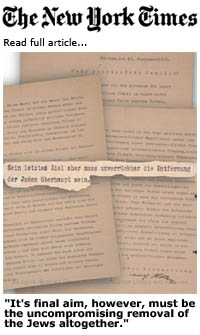| |
 |
| |
-Excerpt from Gemlich letter written and signed by Adolf Hitler, Sept. 16, 1919
|
This week, the Simon Wiesenthal Center announced that it had acquired the most significant document in its 34-year history (see New York Times article). The document, a 4-page letter signed by Adolf Hitler, dated September 16, 1919, six years before the publication of Mein Kampf describes his hatred of Jews outlining his plans which call for, "The uncompromising removal of the Jews altogether," which he says can only be accomplished, "Under a government of National strength and never under a government of National impotence." Hitler warns against an "emotional anti-Semitism which will always find its expression in the form of pogroms" and seeks rather "a legal ... removal of the rights of the Jew."
"What began as a private letter, one man's opinion, twenty-two years later became the 'Magna Carta' of an entire nation and led to the nearly total extinction of the Jewish people. This is an important lesson for future generations," said Rabbi Marvin Hier, Wiesenthal Center Dean and Founder. "Demagogues mean what they say and given the opportunity, carry out what they promise," he concluded.
The document will be on permanent display at the Museum of Tolerance in Los Angeles at the entrance to the Holocaust section, opening on July 11, 2011.
The Wiesenthal Center archives is one of the largest Holocaust collections holding over 50,000 artifacts and memorabilia including photographs, thousands of documents, diaries, letters, artwork, and rare books. These include original letters of Anne Frank, a recreation of Simon Wiesenthal's Vienna office, an original letter written by Albert Einstein, a telephone from the Commandant's office in Auschwitz, and a handmade American flag presented by the inmates of the Mauthausen concentration camp to their American liberators. Many of these archives are currently on display at at the Museum of Tolerance Los Angeles.
|